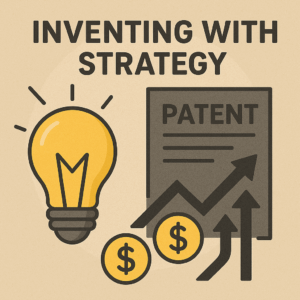 In the world of innovation, coming up with a cool invention is exciting. But if your end goal is to build a business or earn money from your ideas, then invention alone isn’t enough. A thoughtful, strategic patent planning approach is crucial for turning creativity into tangible value.
In the world of innovation, coming up with a cool invention is exciting. But if your end goal is to build a business or earn money from your ideas, then invention alone isn’t enough. A thoughtful, strategic patent planning approach is crucial for turning creativity into tangible value.
Let’s explore what it really means to invent with strategy—and how to use patents as a business-building tool, not just a legal checkbox.
The Real Goal: Turning Ideas Into Income
The goal isn’t just to invent something impressive or to secure a patent for the sake of it. The real goal for most inventors is to generate revenue from their ideas.
Patents—and even pending applications—can serve as valuable business assets. They enable you to:
- License or sell your invention,
- Protect your market position,
- Strengthen negotiations with investors or partners.
But to unlock that value, you need a patent strategy that aligns with your business objectives.
Learn more about the patent basics at https://www.uspto.gov/patents/basics
Patents as Strategic Assets
A patent gives you exclusive rights, and exclusive rights have value. You can often make deals with companies before the patent is granted—provided you’ve filed a well-drafted application.
The further you’ve progressed in developing your invention, the more attractive it becomes:
- A prototype answers technical questions and builds trust.
- An issued patent removes uncertainty about legal rights.
These assets help de-risk your idea for potential partners and increase the likelihood of business success.
Think Beyond “A Patent”
Many inventors focus on getting one patent. But one patent is just a brick—not a wall. If your invention is commercially viable, it likely deserves multiple patents covering:
- Core concepts,
- Variations,
- Improvements,
- Alternative embodiments.
This portfolio approach builds a stronger, more defensible position, especially useful when licensing or selling your IP.
First Things First: Secure the Foundation
To start building your patent wall, you need a solid first patent application. It should:
- Fully describe your invention and its variations,
- Be strategically written to allow future continuation filings,
- Serve both short-term goals (initial protection) and long-term flexibility.
This is where guidance from a qualified patent practitioner or inventor coach can be invaluable.
Add-On Strategy: Use Continuation-in-Part (CIP) Filings to Evolve Your Invention
As your invention grows or new features emerge, you may find that your original patent application no longer fully captures your innovation. That’s where a Continuation-in-Part (CIP) application becomes a powerful and strategic patent planning tool.
A CIP allows you to:
- Add new subject matter to an existing (pending) patent application
- Preserve earlier priority dates for the original material
- Maintain a continuous filing chain for future strategic flexibility
Why This Matters:
- Agile Innovation: Product development rarely stands still. A CIP lets you stay legally current with technical improvements without starting from scratch.
- Portfolio Expansion: You can generate multiple patents stemming from a single invention—each reinforcing the others and expanding your IP fortress.
- Faster Leverage: While new claims in the CIP will receive a new priority date, original claims retain the earlier date—creating a blend of fast protection and future-proofing.
Best Practices for CIP Use:
- File CIPs before the parent application issues—once granted, it’s too late.
- Work closely with your patent professional to align new features with business goals.
- Consider CIPs as part of your planned patent timeline, not just a fallback.
When used strategically, Continuation-in-Part applications become a bridge between past protection and future opportunity, ideal for growing inventions, evolving products, and long-term market positioning.
6 Smart Patent Strategies for Speed and Leverage
Need to move fast? Here are six proven strategies to help you secure patent rights more efficiently:
1. Don’t Overlook Design Patents
Design patents protect appearance, not function—but they’re fast, cost-effective, and powerful. Issued in as little as 9–12 months, they’re ideal for tangible products and excellent for stopping copycats at trade shows. If you want to say your product is “patented” quickly, this is a strong route.
For more information on design vs. utility patents check out this article: https://inspiredideasolutions.com/design-patent-utility-patent/
2. Help Examiners Go Out of Order
Filing with a small number of narrow claims increases the chance your application gets picked up early—especially by time-crunched examiners trying to meet quota. It’s a clever way to gain momentum without paying extra for fast-track services.
3. Acquire Patents at Risk of Expiration
Some inventors let patents lapse due to unpaid maintenance fees. This opens a window to acquire useful patents for minimal cost. If you’re building a portfolio—or want exclusivity on existing tech—this is a low-cost, high-leverage strategy.
4. Use Early Interviews to Shape the Outcome
Examiners get credit for pre-action interviews. If you file narrow, well-written claims and proactively schedule an interview, you may be able to tweak your application early—potentially leading to a faster allowance and a strong first patent.
5. Leverage the Patent Prosecution Highway (PPH)
If you can get a patent approved in countries like Canada, you may fast-track U.S. approval through the PPH. While it requires a foreign filing license and extra cost, this can be a strategic move if you’re targeting markets across North America.
6. Pay for Prioritized Examination (Track One)
If time is of the essence, Track One lets you buy speed. For an extra fee ($1,000–$2,000), the USPTO moves your application to the front of the line—often producing results in under 12 months. This is a direct, effective option for those who can afford it.
Conclusion: Invent Smart, Patent Smarter
Your invention might be brilliant—but without a business-savvy patent strategy, it may never reach its full potential.
Whether your goal is to license, sell, or launch your own product, the journey starts with a single step: getting that first strategically crafted patent. From there, building a layered patent portfolio increases your leverage, protects your rights, and enhances your business value.
Need help plotting your path to strategic patent planning? Reach out to a trusted patent professional or coach who can help align your innovation with your income goals.



